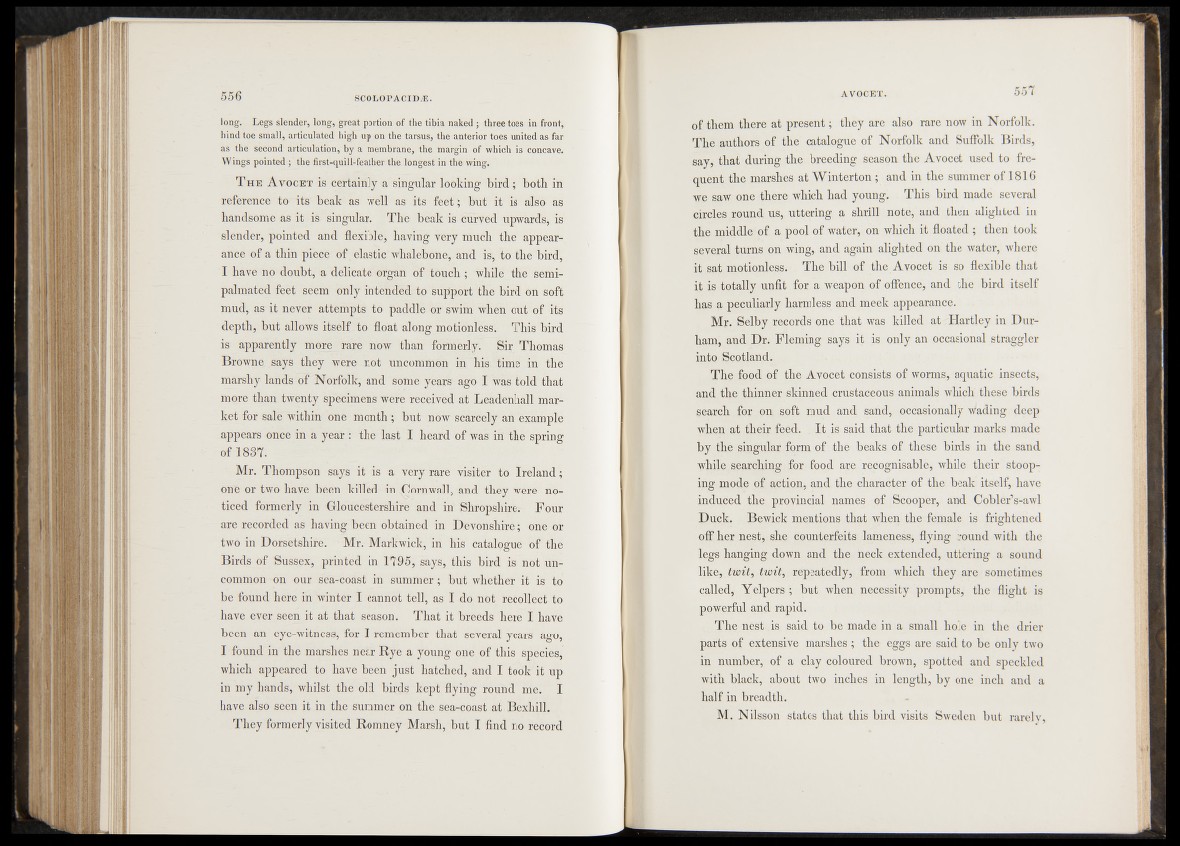
long. Legs slender, long, great portion of the tibia naked ; throe toes in front,
hind toe small, articulated high up on the tarsus, the anterior toes united as far
as the second articulation, by a membrane, the margin of which is concave.
Wings pointed j the first-quilkfeather thelongest in the wing.'
T h e A v o c e t is certainly a singular looking bird; both in
reference to 'its beak as well as its feet ; but it is also as
handsome as it is^ singular. The- beak is curved upwards, is
slender, pointed and flexible, having very much the appearance
of a thin piece of. elastic'whalebone,, and is, to the bird,
I have nó doubt, a delifcate'organ of touch ; while the semi-
palmated feet seem only intended to support the bird on soft
mud, as it never attempts to paddle or swim when out'of its
depth, but allows itself..to float along motionless: This bird
is apparently more rare now than formerly. Sir Thomas
Browne, ,says they were. not uncommon in his time in the
marshy lands of Norfolk, and 'some4 yèarsJago I was told' that
more than twenty specimens were received at Leadenhall market
for sale within one month;- but now scarcely an example
appears once in a year : the last I heard of was ire the spring
of 1837.
Mr. Thompson says it -is a very rare visiter to Ireland;
one or two have been killed- in .Gomwall, and they were noticed
formerly in Gloucestershire and in Shropshire. Four
are recorded as having been obtained in Devonshire; olie or
two in Dorsetshire. Mr. Markwick, in his catalogue of the
Birds of Sussex, printed in 1795;;’says, this bird is not uncommon
-on our séa-coast in summer; but whether i t is to
be found here in winter I cannot tell, as I do not recollect to
have ever seen it at that season. That it breeds here I have
been an eye-witness, for I remember that several years ago,
I found in the marshes near Rye a young one of this species,
which appeared to have been just hatched, and I toöFit up
in my hands, whilst the old birds kept flying round me. I
have also seen it in the summer on the sea-coast at BexhiU. ,
They formerly visited Romney Marsh, but I find no record
of them there at present; they are also rare now in Norfolk.
The authors of the catalogue of Norfolk and Suffolk Birds,
say, that during the breeding season the Avocet used to frequent
the marshes at Winterton; and in the summer of 1816
we saw one there which had young. This bird made several
circles round us, uttering a shrill note, and then alighted in
the middlemf a pool of water, on which it floated ; then took
several turns on wing, and again alighted on the water, where
it sat motionless. The bill of the Avocet is so flexible that
it is totally unfit for a weapon of offence, and the bird itself
has a peculiarly harmless and meek appearance.
Mr. Selby .records one/that was killed at-rHartley in Durham,
and Dr. Fleming says it is only an occasional straggler
into Scotland.
The food of the. Ayocet consists of worms, aquatic insects,
and the thinner skinned crustaceous animals which' these birds
Search for on*, soft mud and sand, occasionally Wading deep
when at their feed. I t is1 said that the particular marks made
by the singular form of the beaks of these birds in the sand
while,searching .for food are. recognisable, while their stooping
mode of auction, and the character of the beak itself, have
induced the provincial names of Scooper, and Cobler’s-awl
Duck. Bewick mentions .that when:the.female is frightened
off her nest, she counterfeits lameness; flying round with the
legs hanging down and the neck extended, uttering a sound
like,. twit, twit, repeatedly, from which they are sometimes
called, Yelpers; but when; necessity prompts, the flight is
powerful and rapid.
: The nést ..is. said to be made in a small hole in the drier
parts of extensive marshes ; the eggs are said to be only two
in number, of a clay coloured brown, spotted and speckled
with black, about two inches in length, by one inch and a
half in breadth.
M. Nilsson states that this bird visits Sweden but rarely,